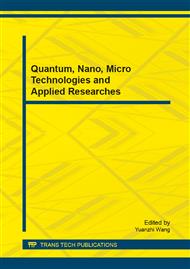p.3
p.7
p.14
p.21
p.27
p.30
p.36
p.40
Synthesis of Copper Nanoparticles at Room Temperature Using Hydrazine in Glycerol
Abstract:
Copper nanoparticles (CuNPs) have been prepared by the reduction of copper chloride in glycerol using hydrazine at ambient conditions. The reduction process takes place under vigorous stirring for 8 h. The formation of CuNPs and size were confirmed by UV/Vis analysis and TEM imaging respectively. The experiment result showed that, 7.062 mM of hydrazine solution and 0.0147 mM of Cu2+ solution were needed to synthesize narrow size monodisperseCuNPs.The presence of nanoparticle was found after an induction period of 4 h and further reaction time, complete Cu0 state nanoparticle was obtained as deep red wine colour was observed. Stability study of CuNPs showed that the nanoparticles were stable up to 4 days. The particle size of the nanoparticles have been analysed by transmission electron microscopy (TEM) and the average size of CuNPs was in the range 2 to 10 nm.
Info:
Periodical:
Pages:
21-26
Citation:
Online since:
December 2013
Authors:
Keywords:
Price:
Сopyright:
© 2014 Trans Tech Publications Ltd. All Rights Reserved
Share:
Citation:


